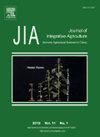Assessment of Land Suitability Potentials for Selecting Winter Wheat Cultivation Areas in Beijing, China, Using RS and GIS
Abstract
It is very important to provide reference basis for winter wheat quality regionalization of cultivation area. The aim of this article was based on factors affecting wheat quality and setting realistic spatial models in each part of the land for assessment of land suitability potentials in Beijing, China. The study employed artificial neural network (ANN) analysis to select factors and evaluate the relative importance of selected environment factors on wheat grain quality. The spatial models were developed and demonstrated their use in selecting the most suitable areas for the winter wheat cultivation. The strategy overcomes the non-accurate traditional statistical methods. Satellite images, toposheet, and ancillary data of the study area were used to find tillable land. These categories were formed by integrating the various layers with corresponding weights in geographical information system (GIS). An integrated land suitability potential (LSP) index was computed considering the contribution of various parameters of land suitability. The study demonstrated that the tillable land could be categorized into spatially distributed agriculture potential zones based on soil nutrient and assembled weather factors using RS and GIS as not suitable, marginally suitable, moderately suitable, suitable, and highly suitable by adopting the logical criteria. The sort of land distribution map made by the factors with their weights showed more truthfulness.

 求助内容:
求助内容: 应助结果提醒方式:
应助结果提醒方式:


